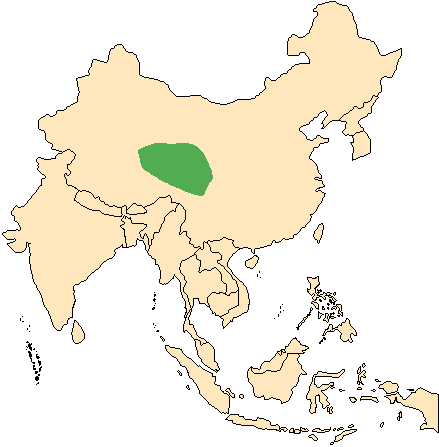![]() Return
to Artiodactyla
Return
to Artiodactyla
Classification
|
 Przewalskium
albirostris
Przewalskium
albirostris
Thorold's deer, White-lipped deer
![]()
Taxonomy
 |
 |
 |
Click on the pictures above for a larger view of the
photographs
|
||
General Characteristics
Body Length: 190-200 cm / 6.3-6.6 ft.
Shoulder Height: 120-130 cm / 4-4.3 ft.
Tail Length: 10-12 cm / 4-4.8 in.
Weight: 130-140 kg / 286-308 lb.The deep brown summer coat is highlighted with white markings. As the name albirostris suggests, the most prominent of these is the white muzzle, which is covered in pure white hair. As well, the underparts, rump, eye-ring, throat, and underside of the chin are creamy white. In winter, this coat is replaced by longer grey-brown hairs which reduce the contrast of the markings. A peculiar feature of the coat is the reversal in the lie of the hairs on the rear torso, which, from a distance, give this deer the appearance of wearing a saddle. The hoofs are broad and cattle-like, with well developed dew claws. The antlers, worn only by males, are spectacular - the thick main beam normally carries 5-6 somewhat flattened tines and may reach a length of 1.3 meters / 4.2 feet. White in colour, the antlers may weigh as much as 7 kg / 15 lb each!
Ontogeny and Reproduction
Gestation Period: 270 days.
Young per Birth: 1, rarely 2.
Weaning: At 10 months.
Sexual Maturity: At 15 months.
Life span: 16-18 years.The rut occurs in October and November, with the young being born in May and June.
Ecology and Behavior
Years of hunting have made Thorold's deer extremely shy and wary, making them very difficult to observe in the wild. The senses of this large deer are acute, especially sight, which is thought to facilitate group cohesion in the open highlands it calls home. Thorold's deer, despite its large size, is extremely agile and is surprisingly good at climbing rocks. It is sure-footed and can navigate steep slopes with apparent ease. During the rut, males "roar" loudly.Family group: Matriarchal families and bachelor herds with 5-40 animals. Mature males solitary.
Diet: Grasses.
Distribution
Meadows and mountainous regions above the tree line in Tibet.

Range Map (Redrawn from Whitehead, 1993)
Conservation Status
Thorold's deer is classified as vulnerable by the IUCN (1996) with a global population around 100,000 animals.
Remarks
Also known as the white-lipped deer, Thorold's deer was described by Przewalski in 1883. Although 'discovered' by Przewalski in 1879, this deer's common name is in honour of Dr. W. G. Thorold, who procured the second two specimens from Tibet in 1891. However, some authors do place Thorold's deer in the subgenus Przewalskium.
Cervus (Latin) a stag, deer. Albus (Latin) white; rostrum (Latin) the snout: referring to the white muzzle and lips.
Literature Cited
Butzler, W. 1990. Thorold's deer (Subgenus Przewalskium). In Grzimek's Encyclopedia of Mammals. Edited by S. P. Parker. New York: McGraw-Hill. pp. 196-197.Nowak, R. M. [editor]. 1991. Walker's Mammals of the World (Fifth Edition). Baltimore: The Johns Hopkins University Press.
Whitehead, K. G. 1993. The Whitehead Encyclopedia of Deer. Stillwater, MN: Voyageur Press, Inc.
Wilson, D. E., and D. M. Reeder [editors]. 1993. Mammal Species of the World (Second Edition). Washington: Smithsonian Institution Press. Available online at http://nmnhwww.si.edu/msw/
Return to Artiodactyla

![]()
© Brent Huffman, www.ultimateungulate.com |
|
|